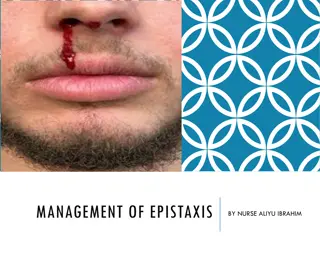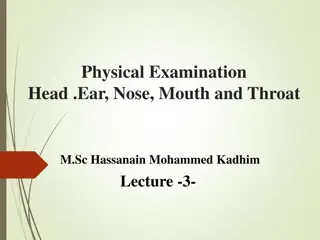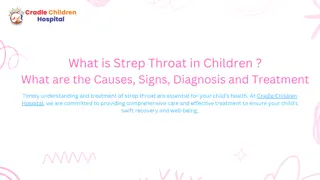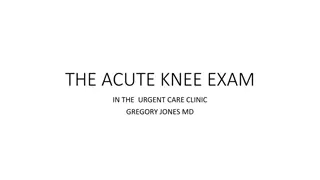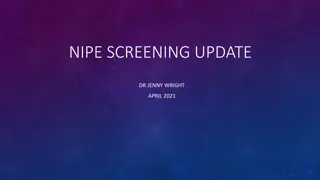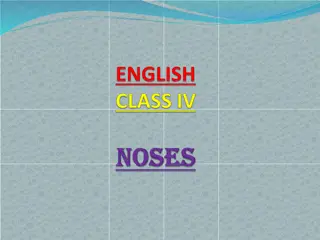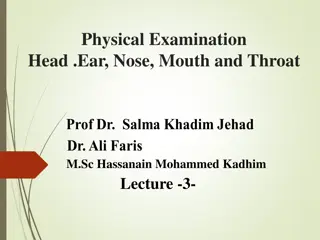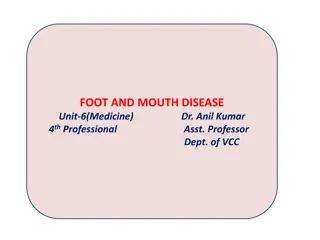Comprehensive Guide to Physical Examination of Nose, Mouth, and Throat
This detailed guide covers the preparation, general approach, equipment needed, subjective data collection, inspection, and palpation techniques for assessing the nose, mouth, and throat during a physical examination. It includes step-by-step instructions, visual aids, and information on normal findings and abnormal signs to look out for.
Download Presentation

Please find below an Image/Link to download the presentation.
The content on the website is provided AS IS for your information and personal use only. It may not be sold, licensed, or shared on other websites without obtaining consent from the author.If you encounter any issues during the download, it is possible that the publisher has removed the file from their server.
You are allowed to download the files provided on this website for personal or commercial use, subject to the condition that they are used lawfully. All files are the property of their respective owners.
The content on the website is provided AS IS for your information and personal use only. It may not be sold, licensed, or shared on other websites without obtaining consent from the author.
E N D
Presentation Transcript
Physical Examination Nose, Mouth and Throat Assistant Lecturer Hassanain Mohammed Kadhim Lecture -4-
Preparation Nurse Environment Client Equipment
General Approach to assess ( Nose, Mouth, and Throat) 1. Greet the patient and explain the assessment techniques that using. 2. Use a quiet room that will be free from interruptions. 3. Ensured that the light in the room provides sufficient brightness adequate observation of the patient. 4. Place the patient in an upright sitting position or for patients who cannot tolerated he sitting position assess head so that it can be rotated from side to side 5. Visualize the underlying structures during the assessment allow adequate description of findings. 6. Always compare right and left ears, as well as right and left nose, sinuses, mouth, and throat ect..
Mouth & Oropharynx Equipment Needed 1. Penlight 2. Tongue blade 3. Small gauze (2*2) 4. Clean gloves
Preparation: 1. Position the client sitting up straight with his \her head at your eye level. 2. Remove client's dentures if available 6. Dysphagia 7. Altered taste 8. Smoking, Alcohol consumption 9. Self-care behaviors, dental care pattern, dentures or appliances Subjective data: I. Sores & Lesions 2.Sore Throat 3. Bleeding gum. 4. Toothache 5. Hoarseness
Inspection & palpation lips Normal Findings Color: in white skin Pink , in dark skin: may have bluish hue or freckle like pigmentation. Movement: symmetrical during smile , open and close . No lesions, swelling, drooping , its moist and smooth . Wearing gloves, inspect & palpate Teeth for the following: The patient's teeth should be clean with no decay, appear white and shiny smooth surfaces and edges. Adults should have a total of 32 teeth with 16 teeth in each arch. Children have a total of 20 teeth with 10 in each arch. Abnormal findings Missing teeth, loose or broken teeth and misaligned teeth.
Wearing gloves, inspect & palpate buccal mucosa for the following: Color: Pink (increased pigmentation often noted in dark- skinned client Consistency : Smooth, moist, without lesions Landmarks : Parotid duct openings are seen small papilla located near upper second molar Retract client's lips to inspect & palpate gums for the following: Color : pink Consistency :Moist, free of lesion and ulcer ,pale or yellow defined in gingivitis
Inspect protruded tongue for the following: Symmetry & texture and color moist; papillae present; symmetrical appearance; midline fissure present , pink ,smooth Inspect ventral surface of the tongue & mouth floor for the following: Color: pink slightly pale Landmarks: Submandibular duct openings are located on both sides of the frenulum , tongue is free of lesions or increased redness; frenulum is centered.
Inspect hard & soft palate for the following: Color & consistency : hard palate is pale irregular while soft palate is pink and soft , spongy Inspect oropharynx for the following: Color : pink Landmarks : Tonsillar pillars symmetrical; tonsils present (unless surgically removed) & without exudates; uvula at midline & rises on phonation.
Grading of Tonsils : 0 : tonsils not visible 1+ tonsils are visible, 2 + tonsils are between the pillars and uvula 3 + tonsils are touching the uvula 4 + tonsils extend to the midline of the oropharynx.
Nasal airflow ( airway patency) The common method via which to formally assess nasal airflow 1. Place thumb over the nostril not being assessed to occlude air flow. 2.Ask the patient to breath in through their nose and note the degree of airflow. 3. Repeat assessment on the other nostril, noting any difference in apparent airflow.
External Look at the external surface of the nose noting: Skin changes e.g. skin lesions / erythema Note any deviation in the nasal bones or cartilage Internal 1. Ask the patient to look forwards, keeping their head in the neutral position. 2. Carefully elevate the tip of the nose with thumb, so that the nasal cavity becomes visible. Use a pen torch or otoscope as a light source to externally illuminate the cavity. 3. Inspect the nasal mucosa for any abnormalities (including the septum). 4. Inspect and compare the nasal cavities alignment (note any septal deviation).


